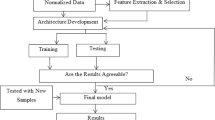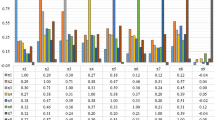Abstract
Automatic classification of the erythemato-squamous diseases is an important problem in dermatology. Despite very little differences, almost all erythemato-squamous diseases have similar clinical features of erythema and scaling. Thus, a hybrid classification model is proposed for automatic classification of the erythemato-squamous diseases. This hybrid model consists of two sub steps. In the first sub step, a feature selection schema is considered. In this context, the association rules (ARs) method is employed for feature selection purposes. The Apriori algorithm is considered as mining the ARs. The fuzzy c-means (FCM) clustering algorithm is located in the second step of the proposed hybrid model where the membership degrees of the data points are obtained through iterative minimization of a cost function. Several experimentations are conducted for evaluating the performance of the proposed hybrid method on detection of the erythemato-squamous diseases on MATLAB environment. We also compared our proposal with the standard FCM and k-means clustering algorithms. The performance evaluation of the proposed method was realized according to the several criterions such as classification accuracy, sensitivity and specificity values. According to the performance evaluation criterions, our proposal yielded better classification performance than the compared clustering methods. While the proposed AR+FCM obtained 75.96% classification accuracy, FCM and k-means produced 75.14 and 68.85% classification accuracies, respectively. Based on the obtained results, the proposed hybrid scheme improves the correct classification rate of erythemato-squamous diseases.

Access this article
We’re sorry, something doesn't seem to be working properly.
Please try refreshing the page. If that doesn't work, please contact support so we can address the problem.
Similar content being viewed by others
References
Duda, R. et al.: Pattern classification. John Wiley. pp. s117–s124 (2001)
Karabatak M., Ince M.C.: A new feature selection method based on association rules for diagnosis of erythemato-squamous diseases. Expert Systems Appl 36((10), 12500–12505 (2009)
Demiroz G., Govenir H.A., Ilter N.: Learning differential diagnosis of erythemato-squamous diseases using voting feature intervals. Artif. Intell. Med. 13, 147–165 (1998)
Govenir H.A., Emeksiz N.: An expert system for the differential diagnosis of erythemato-squamous diseases. Expert System Appl. 18, 43–49 (2000)
Ubeyli E.D., Guler I.: Automatic detection of erythemato-squamous diseases using adaptive neuro-fuzzy inference systems. Comput. Biol. Med. 35, 421–433 (2005)
Nanni L.: An ensemble of classifiers for the diagnosis of erythematosquamous diseases. Neurocomputing, 69, 842–845 (2006)
Polat K., Gunes S.: The effect to diagnostic accuracy of decision tree classifier of fuzzy and k-NN based weighted pre-processing methods to diagnosis of erythemato-squamous diseases. Digit. Signal Process. 16(6), 922–930 (2006)
Ubeyli E.D., Dogdu E.: Automatic detection of erythemato-squamous diseases using k-means clustering. J. Med. System, 34(2), 179–184 (2010)
Agrawal, R.; Imielinski, T.; Swami, A.: Mining association rules between sets of items in large databases, In Proceedings of ACM SIGMOD international conference on management of data, Washington, DC (1993)
Chatterjee C., Roychowdhury V.P., Chong E.K.P.: On relative convergence properties of principal component analysis algorithms. IEEE Trans. Neural Netw. cilt- 9(2), 319–329 (1998)
Sengur A.: An expert system based on principal component analysis, artificial immune system and fuzzy k-NN for diagnosis of valvular heart diseases. Comput. Biol. Med. 38(3), 329–338 (2008)
Sengur A.: An expert system based on linear discriminant analysis and adaptive neuro-fuzzy inference system to diagnosis heart valve diseases. Expert Systems Appl. 35(1-2), 214–222 (2008)
Duda, R.; Hart, P.; Stork, D.: Pattern classification (2nd ed.). John Wiley and Sons, New York (2001)
Bezdek J.: Pattern recognition with fuzzy objective function algorithms. Kluwer Academic Publishers Norwell, New York, MA, USA (1981)
Nanni L.: An ensemble of classifiers for the diagnosis of erythemato-squamous diseases. Neurocomputing 69(7), 842–845 (2006)
Author information
Authors and Affiliations
Corresponding author
Rights and permissions
About this article
Cite this article
Tekin, A. Classification of Erythemato-Squamous Diseases Using Association Rules and Fuzzy c-Means Clustering. Arab J Sci Eng 39, 4699–4705 (2014). https://doi.org/10.1007/s13369-014-1168-6
Received:
Accepted:
Published:
Issue Date:
DOI: https://doi.org/10.1007/s13369-014-1168-6




